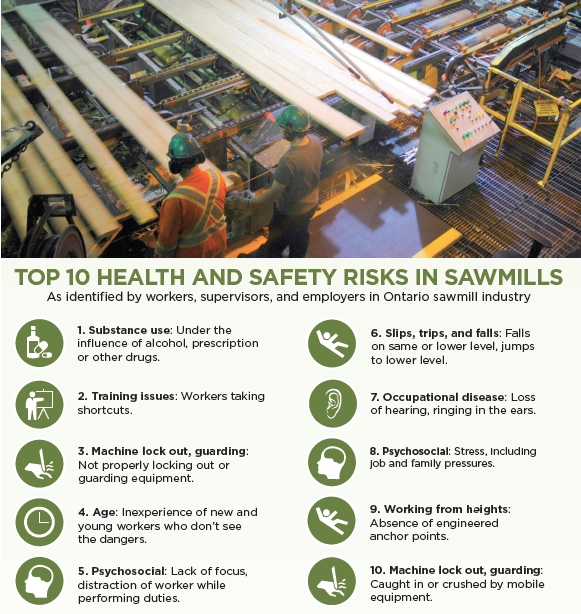
Features
Health and Safety
Sawmilling
Top 10 health and safety risks in Ontario sawmills
April 10, 2018 - Last summer, a volunteer group met face-to-face for a workplace risk assessment at Workplace Safety North (WSN) headquarters in North Bay, Ont. Fifteen sawmill industry representatives from management, labour, government, and not-for-profit organizations attended a workshop facilitated by Sujoy Dey, Ph.D., Corporate Risk Officer at the Ministry of Labour (MOL).
April 10, 2018 By Workplace Safety North

The top 10 risks are based on 86 risks identified by industry experts during the day-long workshop. “We asked the group, ‘What keeps you up at night?’ and both workers and managers agreed: the number one risk in sawmills is substance abuse.” says Dr. Dey. He noted the category includes not just alcohol and recreational drugs, but also prescription drugs, such as pain medication.
Top 10 health and safety risks in sawmills
1. Substance abuse: Under the influence of alcohol, prescription or other drugs.
2. Training issues: Workers taking shortcuts.
3. Lock out: Not properly locking out or guarding equipment.
4. Age: Inexperience of new, young workers who don’t see the dangers.
5. Psychosocial: Lack of focus, distraction of worker while performing duties.
6. Slips, trips, and falls: Falls on same or to lower level, jumps to lower level.
7. Occupational disease: Loss of hearing, ringing in the ears.
8. Psychosocial: Stress, including job and family pressures.
9. Working from heights: Absence of engineered anchor points.
10. Machine lock out and guarding: Caught in or crushed by mobile equipment.
Being under the influence of alcohol or drugs – prescription or not – is a longstanding safety concern in the workplace. Although there are issues regarding social stigma, privacy, and human rights concerns, drug and alcohol use in the workplace is an issue that’s too risky to ignore.
“A lot of businesses ask WSN for help in creating a drug and alcohol policy for their workplace,” says Tom Welton, WSN Industrial Director. “Sample policies are available, and we recommend contacting the local health unit as an excellent resource for policy development.
www.workplacesafetynorth.ca/news/news-post/your-alcohol-and-drug-policy-date-0
“Overall, the outcome of the risk assessment workshop was very interesting in that the number one risk was not on Workplace Safety North’s radar as a priority concern,” says Welton. “Historically, WSIB [Workplace Safety and Insurance Board] statistics were used to provide a clear picture of workplace injuries and trends, but by using leading rather than lagging indicators, WSN can be more proactive.”
The next step is underway: a detailed analysis of the root causes of substance abuse in the workplace, and the creation of effective workplace controls, such as policy development and effective supervisor training in identifying and dealing with substance use in the workplace. More information will become available later in 2018.
Related:
Sawmill safety infographic package
www.workplacesafetynorth.ca/sites/default/files/Forest_Products_033B_Sawmill_safety_infographic_package_WSN-2017.pdf
Is your workplace drug and alcohol policy up to date? – Workplace Safety North
www.workplacesafetynorth.ca/news/news-post/your-alcohol-and-drug-policy-date
IWH work on provincial review supports new mining safety culture and systems audit tool – Institute for Work and Health
www.iwh.on.ca/at-work/88/iwh-work-on-provincial-review-supports-new-mining-safety-culture-and-systems-audit-tool
Print this page